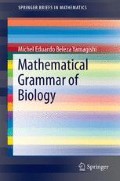Abstract
The Symmetry Principle used to be the only generalization known for Chargaff’s second parity rule. In this chapter, we present the conceptual theoretical framework used to discover four new higher order parity rules.
Access this chapter
Tax calculation will be finalised at checkout
Purchases are for personal use only
Notes
- 1.
The question “Can machines think?” was proposed by Alan Mathison Turing (1912–1954) in 1950. He wrote a manuscript [93] in which he devised a test called “the imitation game,” and replaced the original question with “Are there imaginable digital computers which would do well in the imitation game?” On June 23, 2012, a chatbot named Eugene Goostman was the first to pass the Turing Test [83].
- 2.
Forsdyke proved this statement with a simple example (short DNA sequence) in which there was parity at the mononucleotide level, but no parity at the oligonucleotide level. Although his reasoning was essentially right, we would like to warn readers that long random DNA sequences with parity at the level of mononucleotides necessarily present parity at the oligonucleotide level. We will clarify this issue in Sect. 3.3.5.
- 3.
Formal definition and discussion will be presented in Sect. 3.3.5.
- 4.
Formal definition in Sect. 3.2.
- 5.
This is article [5] in our reference list.
- 6.
In Chargaff’s own words:
The regularities of the composition of deoxyribonucleic-acids—some friendly people latter called them the ‘Chargaff rules’—are as follows: (a) the sum of the purines (adenine and guanine) equals that of the pyrimidines (cytosine and thymine); (b) the molar ratio of adenine to thymine equals 1; (c) the molar ratio of guanine to cytosine equals 1. And, as a direct consequence of these relationships, (d) the number of 6-amino groups (adenine and cytosine) is the same as that of 6-keto groups (guanine and thymine) [14].
- 7.
- 8.
One in which all k-words are different. We know that this not true, because there are a lot of repetitive sequences within human genome.
- 9.
In North America, it is the main vector of Lyme disease.
- 10.
- 11.
Don’t forget February 29.
- 12.
As a comparison, the number of atoms in the “observable” universe is estimated to be about 1080.
- 13.
This word in English has several different connotations. Here, it has a special meaning coined by Dr. Bernard Joseph Francis Lonergan (1904–1984) in his philosophical masterpiece “Insight: A Study of Human Understanding [65],” in which term means “act of understanding.”
- 14.
The same number of amino acids.
- 15.
We will refer to these sequences as Semi-random.
- 16.
This example will aid in the understanding of the discussion in Remark 4.1.
- 17.
When k = 2, as will be discussed in Remark 4.1, the identities are violated slightly.
References
Aristotle: Metaphysics, Book I, 985b
Baisnée, P.-F., Hampson, S., Baldi, P.: Why are complementary DNA strands symmetric? Bioinformatics 18, 1021–1033 (2002)
Chargaff, E.: Heraclitean Fire: Sketches from a Life Before Nature. The Rockefeller University Press, New York (1978)
Chargaff, E.: How genetics got a chemical education. Ann. N. Y. Acad. Sci. 325, 345–360 (1979)
Cohen, J.E.: Mathematics is biology’s next microscope, only better; biology is mathematics’ next physics, only better. Plos ONE 2(12), e439 (2004)
Dong, Q., Cuticchia, A.J.: Compositional symmetries in complete genomes. Bioinformatics 17(6), 557–559 (2001)
Forsdyke, D.R.: Relative roles of primary sequence and (G+C)% in determining the hierarchy of frequencies of complementary trinucleotide pairs in DNAs of different species. J. Mol. Evol. 41, 573–581 (1995)
Forsdyke, D.R., Bell, S.J.: Purine-loading, stem-loops, and Chargaff’s second parity rule: a discussion of the application of elementary principles to early chemical observations. Appl. Bioinformatics 3, 3–8 (2004)
Gulia-Nuss, M., Nuss, A.B., et al.: Genomic insights into the Ixodes scapularis tick vector of Lyme disease. Nat. Commun. 7, 10507 (2016)
Hilbert, D., Ackermann, W.: Principle of Mathematical Logic. AMS Chelsea Publishing, Providence (1999)
Kline, M.: Mathematics for the Nonmathematician. Dover, New York (1967)
Kong, S.-G., Fan, W.-L., Chen, H.-D., Hsu, Z.-T., Zhou, N., et al.: Inverse symmetry in complete genomes and whole-genome inverse duplication. PLoS ONE 4(11), e7553 (2009). doi:10.1371/journal.pone.0007553
Lonergan, B.J.F.: Insight: a study of human understanding. Philosophical Library, New York (1965)
Prabhu, V.V.: Symmetry observation in long nucleotide sequences. Nucleic Acids Res. 21, 2797–2800 (1993)
Shah, H., Warwick, K., Vallverdú, J., Wu, D.: Can machines talk? comparison of Eliza with modern dialogue systems. Comput. Hum. Behav. 58, 278–295 (2016)
Turing, A.M.: Computing machinery and intelligence. Mind 49, 433–460 (1950)
Wright, A.V., Nuñez, J.K., Doudna, J.A.: Biology and application of CRISPR systems: harnessing natures’s toolbox for genome engineering. Cell 164, 29–44 (2016)
Yamagishi, M.E.B., Shimabukuro, A.I.: Nucleotide frequencies in human genome and Fibonacci numbers. Bull. Math. Biol. 70, 643–653 (2008)
Zinoviev, V.V., Yakishchik, S.I., Evdokimov, A.A., Malygin, E.G., Hattman, S.: Symmetry elements in DNA structure important for recognition/methylation by DNA [amino]-methyltransferases. Nucleic Acids Res. 32(13), 3930–3934 (2004)
Author information
Authors and Affiliations
Rights and permissions
Copyright information
© 2017 The Author(s)
About this chapter
Cite this chapter
Yamagishi, M.E.B. (2017). Expanding the Grammar of Biology. In: Mathematical Grammar of Biology. SpringerBriefs in Mathematics. Springer, Cham. https://doi.org/10.1007/978-3-319-62689-5_3
Download citation
DOI: https://doi.org/10.1007/978-3-319-62689-5_3
Published:
Publisher Name: Springer, Cham
Print ISBN: 978-3-319-62688-8
Online ISBN: 978-3-319-62689-5
eBook Packages: Mathematics and StatisticsMathematics and Statistics (R0)

